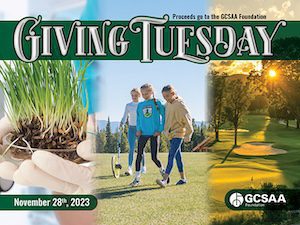Time to start planning for Annual Bluegrass
August is an important month for golf course superintendents to start thinking about weed management programs for winter annuals, particularly annual bluegrass (Poa annua). Although daily high temperatures are still > 90°F in many parts of the transition zone, night-time temperatures will soon begin to fall; couple that with shorter days and ample moisture in soil (from abnormally high summer rainfall totals in many locations) and one has an environment for annual bluegrass seed germination. This can be problematic for those intending to manage annual bluegrass with preemergence herbicides, such as prodiamine, that need to be applied prior to annual bluegrass emergence from soil.
Take the time in early August to ensure that annual bluegrass will be controlled for the duration of the 2015-2016 winter season. Care must be taken in developing effective annual bluegrass control programs for golf course turf given the threat of plants evolving resistance to many pre- and postemergence herbicides when applied consecutively over multiple seasons. The following steps may help.
Evaluate historical programs and their performance
Was the annual bluegrass control program applied last season effective? If so, how many years in a row has it been implemented? It may seem counterintuitive to move away from an effective program but diversifying approaches for controlling annual bluegrass is critically important for preventing the evolution of herbicide resistance on the golf course. Simply applying the same herbicide every season will only select for annual bluegrass biotypes that are genetically capable of surviving that application.
If last year’s program was ineffective, attempt to determine what might be causing poor performance. Was a preemergence herbicide applied after germination? Was the full label rate applied with calibrated equipment? Were weather conditions (rainfall, temperature, etc.) optimal for performance? These factors should all be reviewed before implementing an annual bluegrass control program for 2015-2016. If everything was done correctly and performance was still poor, that should be a strong indicator that resistance may be developing on the course and a change in approach is warranted this season. When applying postemergence herbicides, watch for affected and non-affected weeds intermixed with one another in the same treated area. This is another signal that resistance is building within a weed population.
Diversify across facility
Diversifying an annual bluegrass control program does not mean that whatever was applied to all 18 holes last year needs to be completely changed this season. It can be very productive to manage the golf course in a site-specific manner and rotate annual bluegrass control strategies in different areas. For example, an 18-hole course could be sub-divided into three groups of six holes. Each subset of six holes could receive a different annual bluegrass management program based on seed pressure, environmental conditions, etc. These approaches could then be rotated among these six-hole subsets each year to mitigate the threat of resistance evolving within the annual bluegrass population.
Use a recommended program
In warm-season turf, we have many effective options for annual bluegrass control that can be applied at preemergence (PRE), late pre/early postemergence (PRE/POST), or postemergence (POST) timings. Each year the University of Tennessee tests these herbicides at multiple locations across the state to provide end-users with information about optimal programs in the transition zone. A summary of top programs from the 2014-2015 season is presented in Figure 2. These treatments all provided ≥ 90% annual bluegrass control through April 2015 at a minimum of two locations; therefore, all of these would be recommended for this season and could serve as potential rotational options for those that have been applying the same product for annual bluegrass control for several years consecutively.
Last season, there were more effective PRE/POST programs in our research than any other application timing. This is likely because annual bluegrass can have multiple germination flushes throughout the winter season so applying herbicides that have both POST (to control emerged plants) and PRE activity (to control those not emerged from soil) is beneficial.

Top performing annual bluegrass programs in research trials at the University of Tennessee during 2014-2015.
See More information on annual bluegrass control and resistance management in warm-season turf can be accessed via a recent GCSAA Webinar
Poa annua Control and Resistance Management in Warm-Season Turf
Have something to add to this? Share it in the comments section below.



